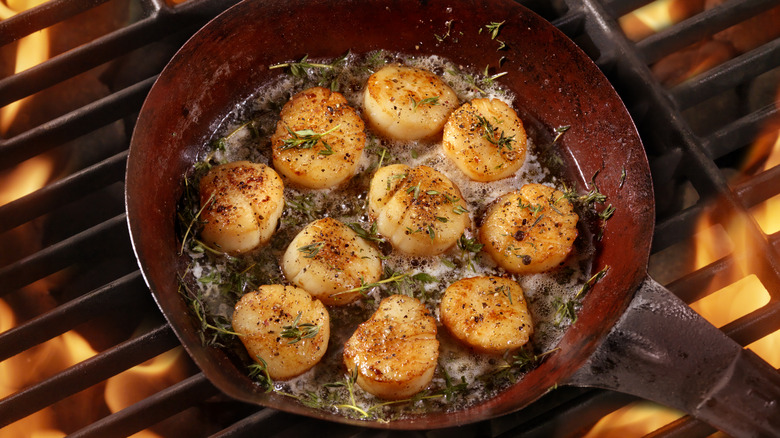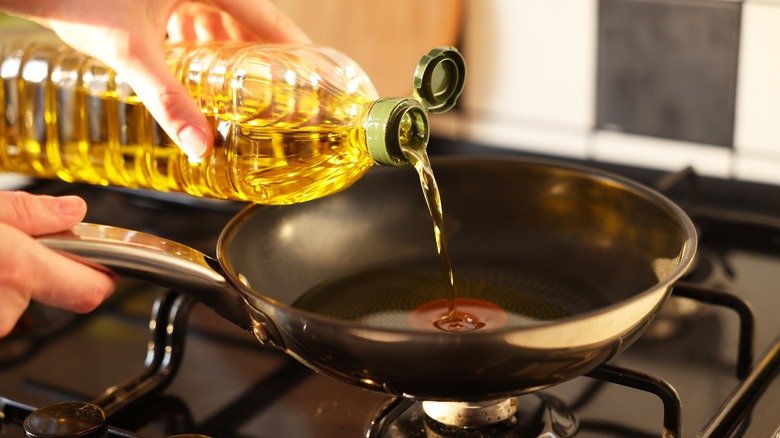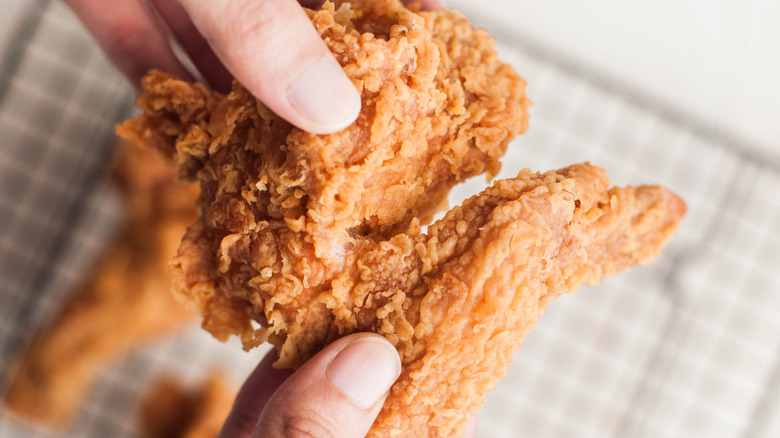The Actual Difference Between Pan-Frying And Deep-Frying
If you're new to cooking, then you may be wondering about the differences between some common cooking techniques — such as pan-frying and deep-frying. Both methods clearly include frying in some way, but what exactly separates the two?
Deep-frying, as the name suggests, refers to cooking foods by fully submerging them in hot oil. Meanwhile, pan-frying refers to cooking foods in a small amount of fat, such as oil or butter, in a shallow pan. With pan-frying, the oil should come up between a quarter and halfway up the pan. This is slightly different from sautéeing, which uses the smallest amount of oil — essentially, just a minimal amount. So, pan-frying uses more oil than sautéeing but less oil than deep-frying; sometimes, it's referred to as "shallow-frying," which reflects the technique (namely, the amount of oil used) a bit more accurately. Additionally, pan-frying refers to flipping the food just once (while sautéeing may require more movement, such as tossing or frequent flipping).
As for the temperatures that each technique requires, pan-frying typically calls for you to cook over medium heat, usually heating the oil or fat first. With deep-frying, the temperatures must be more exact — typically between 350 and 375 degrees Fahrenheit.
What to know about pan-frying
Now that we know the difference between the two, an important question comes next: which foods should you pan-fry, and which foods should you deep-fry? Some of the best options for pan-frying are meat and fish, as well as some other seafood. A chicken breast or thigh, a filet of salmon, or even diced tofu are all great options for the pan-frying technique. Daily Meal has a recipe for pan-fried tuna patties that is both delicious and a great place to start if you're new to the pan-frying method. Or, you could try out our pan-fried fish with citrus sauce, which includes calls for sea bass, rockfish, red snapper, or grouper — in other words, this recipe showcases how different filets can all work well with one simple pan-frying technique.
Pan-frying in a moderate amount of oil will result in a crispy exterior without taking away from the original flavor. Whereas, with deep-frying, there is often batter involved to make for a thicker exterior coating — ultimately, this changes the taste of the dish. For example, a chicken thigh could be pan-fried or deep-fried, but the ultimate taste will depend on the method of cooking. If you want a more simplistic approach, one that highlights the natural flavors of the chicken thigh, then pan-frying is the way to go. With deep-frying, you will still taste the chicken, of course, but a lot of the emphasis will be on the crunchy coating as well.
What to know about deep frying
Coming up with foods to deep-fry may be a bit easier because there are plenty of foods known for being deep-fried — such as french fries, fried chicken, or, in the dessert world, churros. There are even more unique dishes, such as deep-fried macaroni balls, or real showstoppers, such as a deep-fried turkey.
But how do you know when you should deep-fry foods? Well, for one, most of the foods mentioned above can't be pan-fried to the same results. For example, if you try to pan-fry fries, the outcome would likely taste more like simple potatoes (such as home fries) — they will have a bit of a crisp to them. But they won't have the exact ratio of crispy on the outside and fluffy on the inside that traditional (deep-fried) fries will. Or, if you tried to make churros using the pan-fry method, the outcome would be much different than the traditional deep-frying method — the churros need to be submerged in oil to create an even, crispy exterior and, like the fries, maintain a soft and fluffy interior. Thus, when it's essential for a dish to have an exterior that is defined by its crunchy or ultra-crispy nature, it's likely that deep-frying is the way to go over pan-frying.


